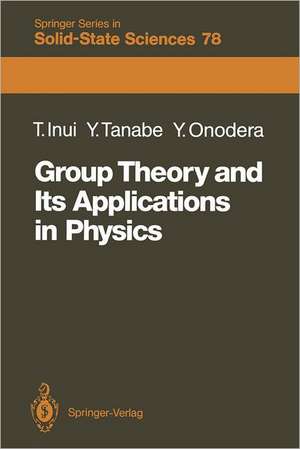Group Theory and Its Applications in Physics: Springer Series in Solid-State Sciences, cartea 78
Autor Teturo Inui, Yukito Tanabe, Yositaka Onoderaen Limba Engleză Paperback – mar 1996
Din seria Springer Series in Solid-State Sciences
- 18%
 Preț: 1225.94 lei
Preț: 1225.94 lei - 18%
 Preț: 1017.62 lei
Preț: 1017.62 lei - 15%
 Preț: 532.05 lei
Preț: 532.05 lei - 18%
 Preț: 944.51 lei
Preț: 944.51 lei -
 Preț: 541.46 lei
Preț: 541.46 lei - 18%
 Preț: 962.35 lei
Preț: 962.35 lei -
 Preț: 385.84 lei
Preț: 385.84 lei - 18%
 Preț: 1827.48 lei
Preț: 1827.48 lei - 15%
 Preț: 661.02 lei
Preț: 661.02 lei -
 Preț: 389.88 lei
Preț: 389.88 lei - 15%
 Preț: 639.59 lei
Preț: 639.59 lei - 15%
 Preț: 635.15 lei
Preț: 635.15 lei - 18%
 Preț: 896.21 lei
Preț: 896.21 lei - 15%
 Preț: 647.92 lei
Preț: 647.92 lei - 15%
 Preț: 651.34 lei
Preț: 651.34 lei - 18%
 Preț: 890.23 lei
Preț: 890.23 lei - 15%
 Preț: 640.55 lei
Preț: 640.55 lei - 15%
 Preț: 649.54 lei
Preț: 649.54 lei - 15%
 Preț: 645.60 lei
Preț: 645.60 lei - 15%
 Preț: 644.30 lei
Preț: 644.30 lei - 15%
 Preț: 653.79 lei
Preț: 653.79 lei - 18%
 Preț: 956.69 lei
Preț: 956.69 lei - 15%
 Preț: 637.59 lei
Preț: 637.59 lei - 23%
 Preț: 1043.41 lei
Preț: 1043.41 lei - 15%
 Preț: 639.08 lei
Preț: 639.08 lei - 15%
 Preț: 648.24 lei
Preț: 648.24 lei - 15%
 Preț: 637.46 lei
Preț: 637.46 lei - 15%
 Preț: 640.06 lei
Preț: 640.06 lei -
 Preț: 391.40 lei
Preț: 391.40 lei -
 Preț: 390.84 lei
Preț: 390.84 lei - 15%
 Preț: 638.57 lei
Preț: 638.57 lei - 18%
 Preț: 1006.06 lei
Preț: 1006.06 lei - 18%
 Preț: 730.79 lei
Preț: 730.79 lei - 15%
 Preț: 640.37 lei
Preț: 640.37 lei - 15%
 Preț: 643.65 lei
Preț: 643.65 lei - 18%
 Preț: 1231.01 lei
Preț: 1231.01 lei - 18%
 Preț: 950.21 lei
Preț: 950.21 lei - 15%
 Preț: 642.68 lei
Preț: 642.68 lei - 15%
 Preț: 640.55 lei
Preț: 640.55 lei - 18%
 Preț: 1229.10 lei
Preț: 1229.10 lei
Preț: 593.26 lei
Preț vechi: 697.96 lei
-15% Nou
Puncte Express: 890
Preț estimativ în valută:
113.54€ • 117.29$ • 94.49£
113.54€ • 117.29$ • 94.49£
Carte tipărită la comandă
Livrare economică 26 martie-09 aprilie
Preluare comenzi: 021 569.72.76
Specificații
ISBN-13: 9783540604457
ISBN-10: 3540604456
Pagini: 416
Ilustrații: XV, 397 p.
Dimensiuni: 155 x 235 x 22 mm
Greutate: 0.68 kg
Ediția:Softcover reprint of the original 1st ed. 1990
Editura: Springer Berlin, Heidelberg
Colecția Springer
Seria Springer Series in Solid-State Sciences
Locul publicării:Berlin, Heidelberg, Germany
ISBN-10: 3540604456
Pagini: 416
Ilustrații: XV, 397 p.
Dimensiuni: 155 x 235 x 22 mm
Greutate: 0.68 kg
Ediția:Softcover reprint of the original 1st ed. 1990
Editura: Springer Berlin, Heidelberg
Colecția Springer
Seria Springer Series in Solid-State Sciences
Locul publicării:Berlin, Heidelberg, Germany
Public țintă
ResearchCuprins
1. Symmetry and the Role of Group Theory.- 1.1 Arrangement of the Book.- 2. Groups.- 2.1 Definition of a Group.- 2.1.1 Multiplication Tables.- 2.1.2 Generating Elements.- 2.1.3 Commutative Groups.- 2.2 Covering Operations of Regular Polygons.- 2.3 Permutations and the Symmetric Group.- 2.4 The Rearrangement Theorem.- 2.5 Isomorphism and Homomorphism.- 2.5.1 Isomorphism.- 2.5.2 Homomorphism.- 2.5.3 Note on Mapping.- 2.6 Subgroups.- 2.7 Cosets and Coset Decomposition.- 2.8 Conjugate Elements; Classes.- 2.9 Multiplication of Classes.- 2.10 Invariant Subgroups.- 2.11 The Factor Group.- 2.11.1 The Kernel.- 2.11.2 Homomorphism Theorem.- 2.12 The Direct-Product Group.- 3. Vector Spaces.- 3.1 Vectors and Vector Spaces.- 3.1.1 Mathematical Definition of a Vector Space.- 3.1.2 Basis of a Vector Space.- 3.2 Transformation of Vectors.- 3.3 Subspaces and Invariant Subspaces.- 3.4 Metric Vector Spaces.- 3.4.1 Inner Product of Vectors.- 3.4.2 Orthonormal Basis.- 3.4.3 Unitary Operators and Unitary Matrices.- 3.4.4 Hermitian Operators and Hermitian Matrices.- 3.5 Eigenvalue Problems of Hermitian and Unitary Operators.- 3.6 Linear Transformation Groups.- 4. Representations of a Group I.- 4.1 Representations.- 4.1.1 Basis for a Representation.- 4.1.2 Equivalence of Representations.- 4.1.3 Reducible and Irreducible Representations.- 4.2 Irreducible Representations of the Group C?v.- 4.3 Effect of Symmetry Transformation Operators on Functions.- 4.4 Representations of the Group C3v Based on Homogeneous Polynomials.- 4.5 General Representation Theory.- 4.5.1 Unitarization of a Representation.- 4.5.2 Schur’s First Lemma.- 4.5.3 Schur’s Second Lemma.- 4.5.4 The Great Orthogonality Theorem T.- 4.6 Characters.- 4.6.1 First and Second Orthogonalities of Characters.- 4.7 Reduction ofReducible Representations.- 4.7.1 Restriction to a Subgroup.- 4.8 Product Representations.- 4.8.1 Symmetric and Antisymmetric Product Representations.- 4.9 Representations of a Direct-Product Group.- 4.10 The Regular Representation.- 4.11 Construction of Character Tables.- 4.12 Adjoint Representations.- 4.13 Proofs of the Theorems on Group Representations.- 4.13.1 Unitarization of a Representation.- 4.13.2 Schur’s First Lemma.- 4.13.3 Schur’s Second Lemma.- 4.13.4 Second Orthogonality of Characters.- 5. Representations of a Group II.- 5.1 Induced Representations.- 5.2 Irreducible Representations of a Group with an Invariant Subgroup.- 5.3 Irreducible Representations of Little Groups or Small Representations.- 5.4 Ray Representations.- 5.5 Construction of Matrices of Irreducible Ray Representations.- 6. Group Representations in Quantum Mechanics.- 6.1 Symmetry Transformations of Wavefunctions and Quantum-Mechanical Operators.- 6.2 Eigenstates of the Hamiltonian and Irreducibility.- 6.3 Splitting of Energy Levels by a Perturbation.- 6.4 Orthogonality of Basis Functions.- 6.5 Selection Rules.- 6.5.1 Derivation of the Selection Rule for Diagonal Matrix Elements.- 6.6 Projection Operators.- 7. The Rotation Group.- 7.1 Rotations.- 7.2 Rotation and Euler Angles.- 7.3 Rotations as Operators; Infinitesimal Rotations.- 7.4 Representation of Infinitesimal Rotations.- 7.4.1 Rotation of Spin Functions.- 7.5 Representations of the Rotation Group.- 7.6 SU(2), SO(3) and O(3).- 7.7 Basis of Representations.- 7.8 Spherical Harmonics.- 7.9 Orthogonality of Representation Matrices and Characters.- 7.9.1 Completeness Relation for XJ(?).- 7.10 Wigner Coefficients.- 7.11 Tensor Operators.- 7.12 Operator Equivalents.- 7.13 Addition of Three Angular Momenta;Racah Coefficients.- 7.14Electronic Wavefunctions for the Configuration (nl)x.- 7.15 Electrons and Holes.- 7.16 Evaluation of the Matrix Elements of Operators.- 8. Point Groups.- 8.1 Symmetry Operations in Point Groups.- 8.2 Point Groups and Their Notation.- 8.3 Class Structure in Point Groups.- 8.4 Irreducible Representations of Point Groups.- 8.5 Double-Valued Representations and Double Groups.- 8.6 Transformation of Spin and Orbital Functions.- 8.7 Constructive Derivation of Point Groups Consisting of Proper Rotations.- 9. Electronic States of Molecules.- 9.1 Molecular Orbitals.- 9.2 Diatomic Molecules: LCAO Method.- 9.3 Construction of LCAO-MO: The ?-Electron Approximation for the Benzene Molecule.- 9.3.1 Further Methods for Determining the Basis Sets.- 9.4 The Benzene Molecule (Continued).- 9.5 Hybridized Orbitals.- 9.5.1 Methane and sp3-Hybridization.- 9.6 Ligand Field Theory.- 9.7 Multiplet Terms in Molecules.- 9.8 Clebsch - Gordan Coefficients for Simply Reducible Groups and the Wigner-Eckart Theorem.- 10. Molecular Vibrations.- 10.1 Normal Modes and Normal Coordinates.- 10.2 Group Theory and Normal Modes.- 10.3 Selection Rules for Infrared Absorption and Raman Scattering.- 10.4 Interaction of Electrons with Atomic Displacements.- 10.4.1 Kramers Degeneracy.- 11. Space Groups.- 11.1 Translational Symmetry of Crystals.- 11.2 Symmetry Operations in Space Groups.- 11.3 Structure of Space Groups.- 11.4 Bravais Lattices.- 11.5 Nomenclature of Space Groups.- 11.6 The Reciprocal Lattice and the Brillouin Zone.- 11.7 Irreducible Representations of the Translation Group….- 11.8 The Group of the Wavevector k and Its Irreducible Representations.- 11.9 Irreducible Representations of a Space Group.- 11.10 Double Space Groups.- 12. Electronic States in Crystals.- 12.1 Bloch Functions and E(k)Spectra.- 12.2 Examples of Energy Bands: Ge and TIBr.- 12.3 Compatibility or Connectivity Relations.- 12.4 Bloch Functions Expressed in Terms of Plane Waves.- 12.5 Choice of the Origin.- 12.5.1 Effect of the Choice on Bloch Wavefunctions.- 12.6 Bloch Functions Expressed in Terms of Atomic Orbitals.- 12.7 Lattice Vibrations.- 12.8 The Spin-Orbit Interaction and Double Space Groups…..- 12.9 Scattering of an Electron by Lattice Vibrations.- 12.10 Interband Optical Transitions.- 12.11 Frenkel Excitons in Molecular Crystals.- 12.12 Selection Rules in Space Groups.- 12.12.1 Symmetric and Antisymmetric Product Representations.- 13. Time Reversal and Nonunitary Groups.- 13.1 Time Reversal.- 13.2 Nonunitary Groups and Corepresentations.- 13.3 Criteria for Space Groups and Examples.- 13.4 Magnetic Space Groups.- 13.5 Excitons in Magnetic Compounds; Spin Waves.- 13.5.1 Symmetry of the Hamiltonian.- 14. Landau’s Theory of Phase Transitions.- 14.1 Landau’s Theory of Second-Order Phase Transitions.- 14.2 Crystal Structures and Spin Alignments.- 14.3 Derivation of the Lifshitz Criterion.- 14.3.1 Lifshitz’s Derivation of the Lifshitz Criterion.- 15. The Symmetric Group.- 15.1 The Symmetric Group (Permutation Group).- 15.2 Irreducible Characters.- 15.3 Construction of Irreducible Representation Matrices.- 15.4 The Basis for Irreducible Representations.- 15.5 The Unitary Group and the Symmetric Group.- 15.6 The Branching Rule.- 15.7 Wavefunctions for the Configuration (nl)x.- 15.8 D(J) as Irreducible Representations of SU(2).- 15.9 Irreducible Representations of U(m).- Appendices.- A. The Thirty-Two Crystallographic Point Groups.- B. Character Tables for Point Groups.- Answers and Hints to the Exercises.- Motifs of the Family Crests.- References.



















